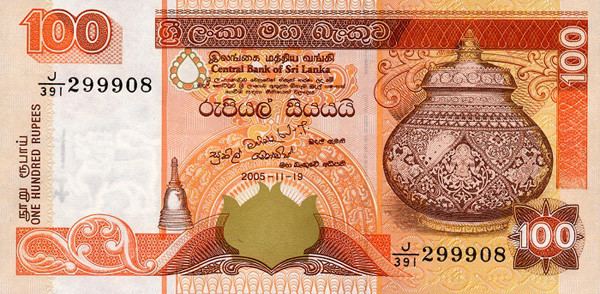100 rupee note 5000 rupee note ⁄100 cents Rarely used රු.10, රු.200, රු.2000 | Code LKR Symbol රු, Rs,ரூ | |
 | ||
Freq. used රු.20, රු.50, රු.100, රු.500, රු.1000, රු.5000 | ||
The rupee (Sinhalese: රුපියල්, Tamil: ரூபாய்) (signs: රු, Rs, ரூ; code: LKR) is the currency of Sri Lanka, divided into 100 cents. It is issued by the Central Bank of Sri Lanka. The abbreviation is generally Rs., but SLRs. is occasionally used to distinguish it from other currencies also called rupee.
Contents
History
The British pound became Ceylon's official money of account in 1825, replacing the Ceylonese rixdollar at a rate of 1 pound = 13 1⁄3 rixdollars, and British silver coin was made legal tender. Treasury notes denominated in pounds were issued in 1827, replacing the earlier rixdollar notes. Rixdollar notes not presented for exchange were demonetized in June 1831.
The Indian rupee was made Ceylon's standard coin on 26 September 1836, and Ceylon reverted to the Indian currency area. Pound-denominated treasury notes continued to circulate after 1836, along with the rupee. The legal currency remained British silver and accounts were kept in pounds, shillings and pence. However, payments were made in rupees and annas at the "fictitious par" (fixed accounting rate) of 2 shillings per rupee (i.e., 1 pound = 10 rupees).
The Bank of Ceylon was the first private bank to issue banknotes on the island (1844) and Treasury notes were withdrawn in 1856.
The Indian rupee was formally established as the unlimited legal tender 18 June 1869. The rupee was decimalized 23 August 1871. Thus, the rupee of 100 cents became Ceylon's money of account and sole legal tender effective 1 January 1872, replacing British currency at a rate of 1 rupee = 2 shillings 3 pence.
Coins
In 1872, copper 1⁄4, 1⁄2, 1 and 5 cents coins dated 1870 were introduced, followed in 1892 by silver 10, 25 and 50 cents. Production of the 1⁄4 cent ceased in 1904. The large, copper 5 cents coin was replaced in 1909 by a much smaller cupro-nickel coin which was square with rounded corners. In 1919, the fineness of silver used was reduced from .800 to .550.
Between 1940 and 1944, a wholesale change in the coinage was carried out. Production of the 1⁄2 cent ceased in 1940, with bronze 1 cent introduced in 1942 with reduced weight and thickness. Nickel-brass replaced cupro-nickel in the 5 cents in the same year and replaced silver in the 25 and 50 cents in 1943. In 1944, nickel-brass, scalloped shaped 2 and 10 cents coins were introduced. The scalloped 10 cents coin replaced the silver 10 cents coin. Later 2 cent coins issued in 1957 were the only coins from this period to ever depict Queen Elizabeth II. Coins with the portrait of King George VI continued to be issued despite his death. In 1957, cupro-nickel 1 rupee coins and .925 silver 5 rupee coins commemorating 2500 years of Buddhism were issued.
In 1963, a new coinage was introduced which omitted the British monarch's portrait, depicting instead The Armorial ensign of Ceylon. Coins issued were aluminium 1 and 2 cents, nickel brass 5 and 10 cents and cupro-nickel 25 and 50 cents and 1 rupee. These coins had the same shapes and sizes of the previous series but were composed of different materials. In 1976, commemorative seven-sided 2 rupee and ten-sided 5 rupee coins were introduced in limited numbers. In 1978, devaluation prompted aluminum to be the replacement of nickel-brass in the 5 and 10 cents, while shortly after 1 and 2 cents were discontinued. Cupro-nickel 2 rupees and aluminium-bronze 5 rupees coins were introduced in 1984 fully replacing the corresponding banknotes. In 1987, commemorative 10 rupees were released which like the 5 cent coin was square with round edges. In 1998 a bimetallic commemorative 10 rupee coin was released. Like earlier forerunner rupee denominations, these were again only issued in limited supply, not intended to replace the corresponding banknotes.
The obverse of the coins issued since 1972 carry the Armorial Ensign of the Republic of Sri Lanka. The reverse of the coin the value in numerals and in Sinhala, Tamil and English below and year of issue at the bottom with SRI LANKA in Sinhala on top. On 14 December 2005, the Sri Lanka central bank issued a new series of coins in the denominations of 25 and 50 cents, 1, 2 and 5 Rupees. The lower denominations of 1, 2, 5 and 10 cents, although legal tender, are not seen in circulation and not in general issued by banks. Furthermore, the minting of these denominations has been discontinued due to associated costs of production and lack of commercial demand.
The observe and reverse designs of the new coins remained identical to the existing circulating coins of the same denominations. However their weights and compositions have been changed to smaller sizes and electroplated steel as opposed to a solid alloy for easier identification purposes and to save on production expense.
On 5 April 2010 Sri Lanka replaced the 10 rupee note with an 11-sided, nickel-steel electroplated coin.
Commemorative coins
The Central Bank of Sri Lanka has issued commemorative coins since 1957.
On 15 December 2010, to mark the 60th Anniversary, the Central Bank of Sri Lanka issued a frosted proof crown size multi-colour silver commemorative coin in the denomination of 5,000 rupees. It was the first multi-colour coin issued by the Central Bank.
Commemorative coins issued by the Central Bank of Sri Lanka:
